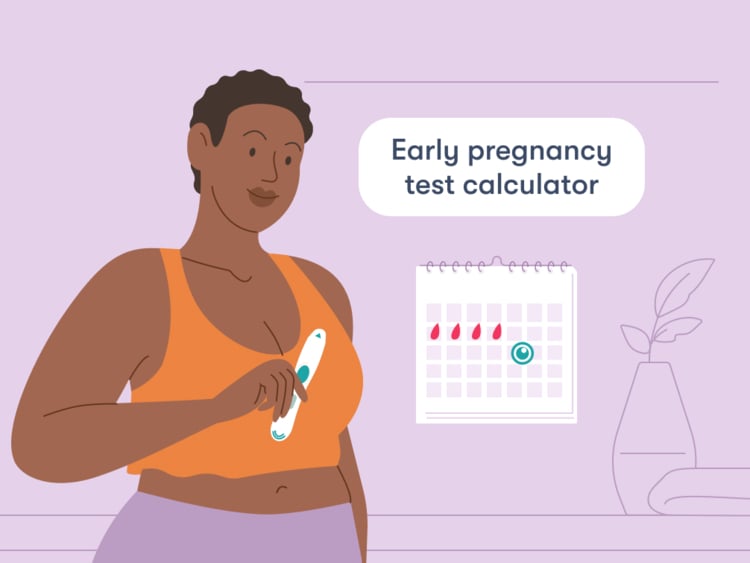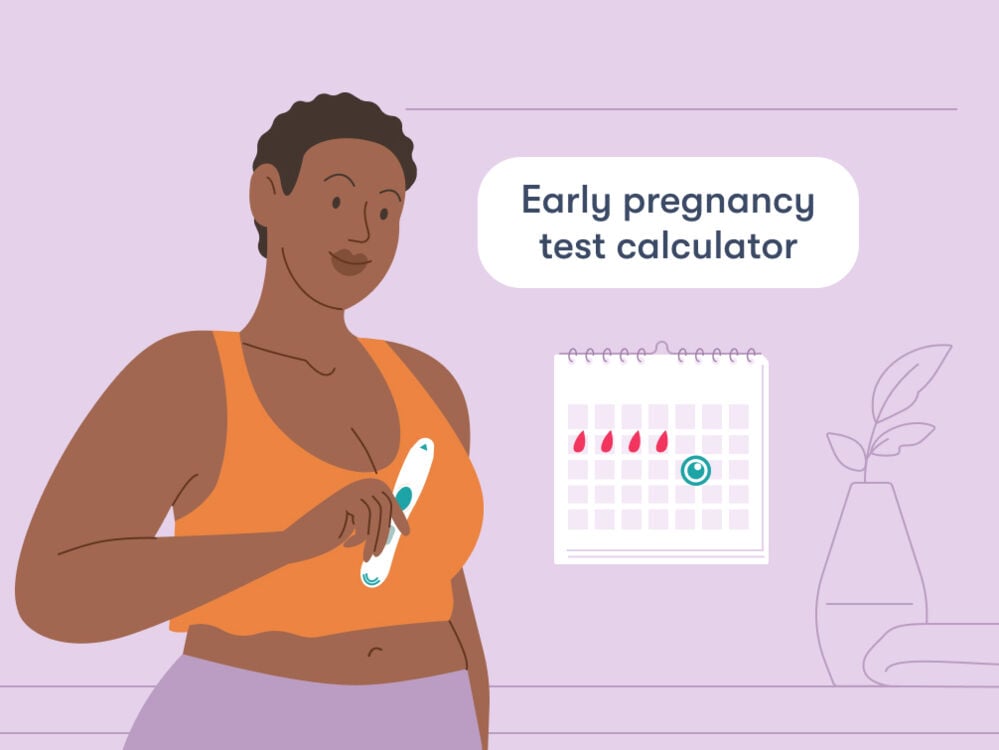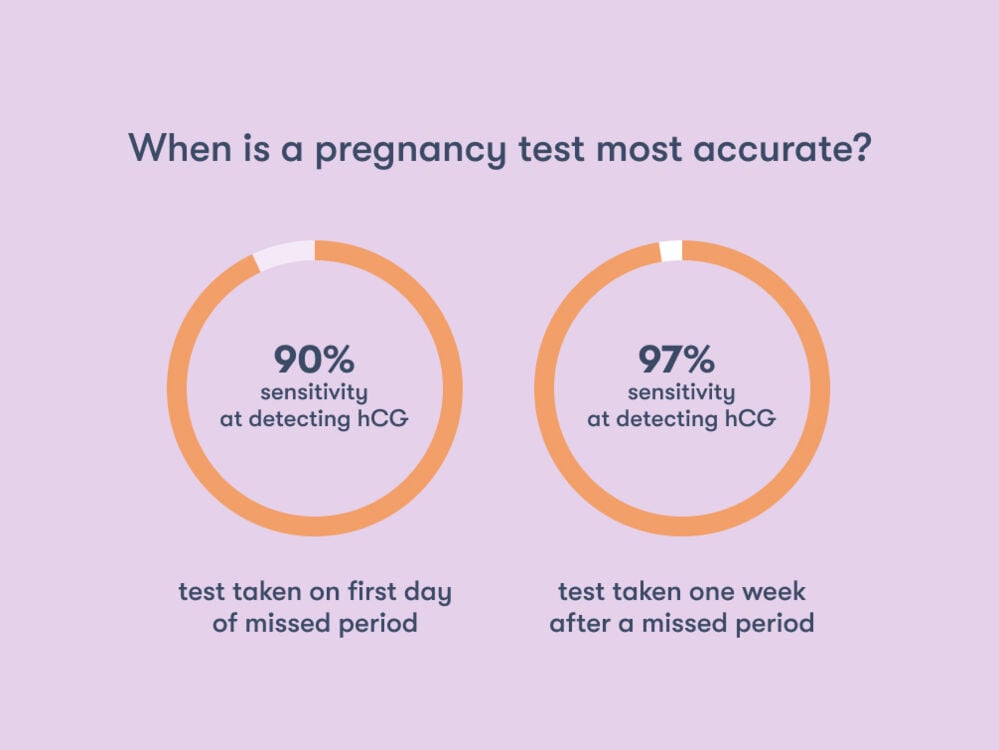-
Tracking cycle
-
Getting pregnant
-
Pregnancy
-
Help Center
-
Flo for Partners
-
Anonymous Mode
-
Flo app reviews
-
Flo Premium New
-
Secret Chats New
-
Symptom Checker New
-
Your cycle
-
Health 360°
-
Getting pregnant
-
Pregnancy
-
Being a mom
-
LGBTQ+
-
Quizzes
-
Ovulation calculator
-
hCG calculator
-
Pregnancy test calculator
-
Menstrual cycle calculator
-
Period calculator
-
Implantation calculator
-
Pregnancy weeks to months calculator
-
Pregnancy due date calculator
-
IVF and FET due date calculator
-
Due date calculator by ultrasound
-
Medical Affairs
-
Science & Research
-
Pass It On Project New
-
Privacy Portal
-
Press Center
-
Flo Accuracy
-
Careers
-
Contact Us
Pregnancy test calculator
If you think you might be pregnant, reaching for a test immediately can be tempting. But how soon can you take a pregnancy test? Learn more about how pregnancy tests work and when you can take one using Flo’s pregnancy test calculator.



Your Flo membership is now active
To start your journey:- 1. Download the Flo app.
- 2. Log in to your account.
- Remember that pregnancy test calculators can help you learn when the best time might be to take one, but they are for informational purposes only. Results are estimates as cycles may vary due to normal monthly shifts or irregularities. Such estimates may cause inaccurate predictions around when to take a pregnancy test, which may lead to a false negative result. If you suspect that you might be pregnant, you should reach out to a health care professional who will be able to give you a more accurate result.
- Please note that Flo Health does not collect, process, or store any of the data that you enter while using these tools. All calculations are done exclusively in your browser. Flo Health does not have access to the results. All data will be permanently erased after leaving or closing the page.

Whether you’re trying for a baby or not, the time between thinking you might be pregnant and knowing for sure can be stressful. No one likes living in uncertainty. So, how soon can you take a pregnancy test? Timing is key when you’re aiming for an accurate result.
You can use Flo’s calculator as a guide for when to take a pregnancy test based on just one piece of information: the first day of your last period or the date you last ovulated. You can also enter your details in the Flo app, which can quickly tell you whether you’re ready to take a pregnancy test or not.
Key takeaways about using a pregnancy test calculator
- It’s generally advised that you wait until the day of a late or missed period before you take a pregnancy test. This is so you get the most accurate result. You might be curious why this is. It’s due to how at-home urine pregnancy tests work.
- Pregnancy tests detect a hormone called human chorionic gonadotropin (hCG) in your urine. Your body starts producing hCG when you become pregnant, and your levels start low and rise through your 1st trimester.
- You need to give your body enough time to produce a detectable amount of hCG in your urine before you take a test.
- Some tests claim to be able to detect hCG earlier than a late or missed period. However, waiting will generally mean you’ll get a more accurate result.
- It’s worth noting that exclusively breastfeeding can make getting pregnant less likely, but it’s not impossible. If you’re breastfeeding, having unprotected sex, and think you might be pregnant, take a pregnancy test on the first day of a missed period or three weeks after you last had sex.
- A very recent miscarriage can impact the accuracy of at-home pregnancy tests, so it’s best to wait until you have your next period before trying to get pregnant again.
When should I take a pregnancy test after a missed period?
The best time to check if you’re pregnant or not is the first day of a late or missed period or later (if you can wait). This is because pregnancy tests get more accurate the longer you wait. Standard at-home pregnancy tests are urine tests that can detect hCG. This is the first indication that you might be pregnant. But it can take a little while for there to be enough hCG in your urine for a pregnancy test to detect.
After a late or missed period, your hCG levels should be enough for a standard test to pick up on it and tell you with clarity whether you’re pregnant or not. Studies have reported that tests taken on the first day that you miss your period can be considered to have 90% sensitivity at detecting hCG. This rises to 97% if you wait one week after you’ve missed your period. [3] It can feel like a waiting game.
Keeping track of when to expect your period can be tough, but using the Flo app can help. Once you’ve inputted your cycle data, it will automatically alert you when your period is late so you’ll know it’s time to test.
When should I take an early pregnancy test?
Although a standard pregnancy test will typically only give you an accurate result once your period is late or you’ve missed it altogether, some brands claim to detect pregnancy earlier than this. Generally speaking, early pregnancy tests are more sensitive to hCG.
Early pregnancy tests can be useful if you’ve been trying to conceive and struggling to wait to take a test. However, it’s important to note that they are considered to be less accurate. This is because your hCG levels are low at the very beginning of pregnancy, and the test may not be able to pick them up. This could lead to a false result. It’s rare for a test to give you a positive result when you’re not pregnant, but you may receive a negative result when you are pregnant if the amount of hCG in your urine is too small for the test to detect.
Take a quiz
Find out what you can do with our Health Assistant
When should I take a pregnancy test after ovulation?
You should wait at least two weeks after you’ve ovulated (when one of your ovaries releases an egg) before taking a pregnancy test. This is because it can take between six and 10 days for your egg to travel down your fallopian tube and implant into your uterine wall. Once implantation happens, your fertilized egg starts to release hCG.
Knowing when you’re ovulating and when your fertile window is (the time in your cycle when you’re most likely to become pregnant) can help you understand any changes throughout your menstrual cycle. An app like Flo can help you track your fertile window every cycle so you always know where you are.
When should I take a pregnancy test after sex?
If your cycle is irregular, or you’re not sure when your period is due, then it’s recommended that you wait at least three weeks to take a pregnancy test after sex.
Otherwise, if you track your period and have a regular cycle, then you can take a standard pregnancy test on the first day of your late or missed period. If you wait a week after your missed period, it’s worth knowing that you may get an even more accurate result.
If you don’t want to have a baby and have had unprotected sex, emergency contraception can help prevent pregnancy. You can use emergency contraception within three to five days after having sex. It is most effective when taken as soon as possible. If you don’t have a withdrawal bleed or period within three weeks of using emergency contraception, you should then take a pregnancy test.
When should I take a pregnancy test while breastfeeding?
If you’re breastfeeding, having unprotected sex, and think you might be pregnant, the same rule applies — you can take a pregnancy test on the first day of a late or missed period or three weeks after you last had sex.
Remember that identifying a new pregnancy soon after a previous one can be difficult. It can take up to 60 days for your hCG levels to return to zero after giving birth. So, if you take an early test during this period, it may detect leftover hCG from your previous pregnancy.
Exclusively breastfeeding your baby can delay the return of your period for around six months and suppress ovulation. This reduces but doesn’t eliminate your chance of becoming pregnant. Everybody is different, after all.
It’s important to keep in mind that ovulation happens before your first period. So if you think you might be pregnant even though your period hasn’t returned yet, you should still take a pregnancy test.
When should I take a pregnancy test after a miscarriage?
Miscarriage can be an intensely emotional and painful time. It can take time for your hCG levels to drop following a miscarriage, and this can vary depending on how far along you were.
Many health care professionals recommend not having sex for around two weeks after you’ve had a miscarriage. This is to protect you from infection. Then, if or when you feel ready to try again, speak to your doctor about the best next step.
It’s possible to ovulate and become pregnant as soon as two weeks after having a miscarriage. If you’ve had unprotected sex after a miscarriage, you can take a pregnancy test about three weeks later, and if it is positive, the hCG detected in the test could indicate a new pregnancy.
What makes a pregnancy test positive?
A pregnancy test will show as positive when it detects a sufficient amount of hCG in your urine. If there’s not enough hCG for the pregnancy test to detect, it will show a negative result.

Once your fertilized egg has attached to your uterine lining (implantation), your body starts to release hCG instantly. It initially does this through your fertilized egg (known as an embryo). Your body produces a whole new organ in early pregnancy called the placenta. It plays a fundamental role in supporting your growing baby. It starts to grow and develop around the 4th week, and even before it’s fully formed, it takes over by releasing hCG.
Are there variations in hCG levels?
Like so much with your cycle, how quickly your hCG levels rise can be pretty personal to you. While hCG generally rises in early pregnancy, peaking at around 10 weeks, levels can slightly differ for everyone. You don’t need to check your blood hCG levels unless your doctor recommends it.
How to take an at-home pregnancy test
If you’ve used Flo’s pregnancy test calculator, your period is late, and it’s time to take a test, here are some things to keep in mind to give yourself the best chance of an accurate result.
- Always read and follow the instructions that came with your test. Some tests work differently than others, so follow the instructions in your pack.
- Make sure the test is within its expiration date. Pregnancy tests can expire, so if the date on the box has passed, go out and get a new test.
- Don’t drink too much water beforehand. The temptation might be to drink lots to produce more urine, but you might dilute it.
- Wash your hands and make sure you’re taking your test in a clean environment.
- Remove the pregnancy test from its wrapper. You will either need to pee directly onto the test or into a clean container or cup and then place the absorbent end of the test stick in the cup. Your test box will explain what you need to do.
- Once you’ve soaked the absorbent end of the stick in urine, place it on a flat surface, facing upward (make sure you can see the little results box).
- You will then need to wait for your results to show. Different brands of pregnancy tests have different reaction times. This is the amount of time it will take to see a result. Make sure you read the instructions carefully.
- Different brands present positive and negative tests differently, so it’s really important to read the box to understand your results.
- Once you’ve waited the stated amount of time and have your result, you can throw your test in the garbage. If you wait too long to read your test result, you may see an evaporation line. This is a faint, colorless line that might appear when moisture evaporates from your test. It’s possible to mix it up with a positive result, so once you’ve taken your test and got your result, you can discard it.
Whether you were trying to conceive or not, a positive pregnancy test result can come with a lot of big feelings — all of which are completely valid. Whether it’s news you wanted, news you didn’t, or somewhere in between, the next thing to do is make an appointment with your doctor, who can discuss your care and options going forward.
You can also use the Flo for Pregnancy app to guide you through every pregnancy stage, from positive test to birth.
Frequently asked questions about the pregnancy test calculator
How do you confirm pregnancy 100%?
The only way to know for certain that you’re pregnant is to take a pregnancy test. The best time to do this is after a missed or late period. Once you’ve received a positive result, you can discuss next steps with a health care professional.
When should I take a pregnancy test, morning or night?
For the most accurate results, experts recommend taking a pregnancy test first thing in the morning. Your urine will be most concentrated in the morning before you’ve had anything to drink. That means that your hCG levels will be at their highest. But if you’re testing after the day of your missed period, most at-home pregnancy tests will be able to give you an accurate result, day or night.
How far into pregnancy will a test be positive?
Technically, hCG can be detected in your blood about 11 days after conception, but it can take a little longer to detect it in your urine. [9] Taking a pregnancy test after a late or missed period reduces the chance of getting a false-negative result. Your missed period will typically be about two weeks after conception, hence the term “two-week wait.”
References
Betz, Danielle, and Kathleen Fane. “Human Chorionic Gonadotropin.” StatPearls, StatPearls Publishing, 2025, www.ncbi.nlm.nih.gov/books/NBK532950/.
Blake, Rachel A. “Can Breastfeeding Really Prevent Pregnancy?” Harvard Health Publishing, 2 Mar. 2022, www.health.harvard.edu/blog/can-breastfeeding-really-prevent-pregnancy-202203022697.
Campbell, Oona M. R., and Ronald H. Gray. “Characteristics and Determinants of Postpartum Ovarian Function in Women in the United States.” American Journal of Obstetrics and Gynecology, vol. 169, no. 1, July 1993, pp. 55–60, DOI: 10.1016/0002-9378(93)90131-2.
“Causes of a False Positive Pregnancy Test.” Cleveland Clinic, 18 Oct. 2021, health.clevelandclinic.org/false-positive-pregnancy-test.
“Conception.” Cleveland Clinic, my.clevelandclinic.org/health/articles/11585-conception. Accessed 22 Jan. 2025.
“Doing a Pregnancy Test.” NHS, www.nhs.uk/pregnancy/trying-for-a-baby/doing-a-pregnancy-test/. Accessed 22 Jan. 2025.
“Effectiveness of Birth Control Methods.” The American College of Obstetricians and Gynecologists, www.acog.org/womens-health/infographics/effectiveness-of-birth-control-methods. Accessed 22 Jan. 2025.
Curtis, Kathryn M., et al. “Emergency Contraception.” US Selected Practice Recommendations for Contraceptive Use. Centers for Disease Control and Prevention, Spring 2024, p.15, www.cdc.gov/contraception/hcp/usspr/emergency-contraception.html.
“Emergency Contraception.” The American College of Obstetricians and Gynecologists, Aug. 2019, www.acog.org/womens-health/faqs/emergency-contraception.
“Fetal Development.” Cleveland Clinic, my.clevelandclinic.org/health/articles/7247-fetal-development-stages-of-growth. Accessed 22 Jan. 2025.
“Home Pregnancy Tests: Can You Trust the Results?” Mayo Clinic, 23 Dec. 2022, www.mayoclinic.org/healthy-lifestyle/getting-pregnant/in-depth/home-pregnancy-tests/art-20047940.
“Human Chorionic Gonadotropin.” Cleveland Clinic, my.clevelandclinic.org/health/articles/22489-human-chorionic-gonadotropin. Accessed 22 Jan. 2025.
Muleba (F), Ndaya, et al. “Human Chorionic Gonadotropin Levels Following Spontaneous Abortion in the First Trimester.” American Journal of Obstetrics and Gynecology, vol. 193, no. 6, suppl. 116, Dec. 2005, www.ajog.org/article/S0002-9378(05)01954-X/fulltext.
“Placenta.” Cleveland Clinic, my.clevelandclinic.org/health/body/22337-placenta. Accessed 22 Jan. 2025.
“Pregnancy after Miscarriage: What You Need to Know.” Mayo Clinic, 6 Mar. 2024, www.mayoclinic.org/healthy-lifestyle/getting-pregnant/in-depth/pregnancy-after-miscarriage/art-20044134.
“Pregnancy Tests.” Cleveland Clinic, my.clevelandclinic.org/health/diagnostics/9703-pregnancy-tests. Accessed 22 Jan. 2025.
Su, Ren-Wei, and Asgerally T. Fazleabas. “Implantation and Establishment of Pregnancy in Human and Nonhuman Primates.” Advances in Anatomy, Embryology, and Cell Biology, vol. 216, 2015, pp. 189–213, doi:10.1007/978-3-319-15856-3_10.
Witt, Barry. “Trying to Get Pregnant? Here’s When to Have Sex.” The American College of Obstetricians and Gynecologists, Aug. 2023, www.acog.org/womens-health/experts-and-stories/the-latest/trying-to-get-pregnant-heres-when-to-have-sex.
Wilcox, A. J., et al. “Natural Limits of Pregnancy Testing in Relation to the Expected Menstrual Period.” JAMA, vol. 286, no. 14, 10 Oct. 2001, pp. 1759–61, doi:10.1001/jama.286.14.1759.


